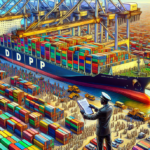Understanding DDP and DAP Shipping Terms in International Trade
International trade requires navigating various complexities, especially when selecting the appropriate shipping terms. Two critical Incoterms that often come into play are DDP (Delivery Duty Paid) and DAP (Delivered at Place). Grasping the distinctions between these terms is essential for businesses engaging with international suppliers and customers.
What is DDP (Delivery Duty Paid) Shipping?
DDP stands for Delivery Duty Paid and is one of the most comprehensive Incoterms in international shipping. Under DDP terms, the seller assumes full responsibility for delivering the goods to the buyer's premises, including all costs and risks associated with transportation, customs clearance, duties, and taxes.
Responsibilities of the Seller
- Arranging and paying for transportation to the agreed destination.
- Handling all export and import customs formalities.
- Paying any duties, taxes, and additional fees required for delivery.
- Ensuring the goods are delivered in compliance with local regulations.
Advantages of DDP
- Simplified Process for Buyers: Buyers are relieved from handling customs and other logistical challenges.
- Enhanced Trust: Sellers demonstrate commitment by managing all aspects of delivery.
Disadvantages of DDP
- Higher Costs for Sellers: Sellers bear all expenses, which may result in higher product pricing.
- Complexity in Compliance: Navigating diverse customs regulations can be challenging and time-consuming.
What is DAP (Delivered at Place) Shipping?
DAP stands for Delivered at Place and represents a middle ground in shipping responsibilities. Under DAP terms, the seller delivers the goods to a specified location, but the buyer is responsible for import customs clearance and paying any duties or taxes.
Responsibilities of the Seller
- Arranging and covering the costs of transportation to the designated location.
- Managing export customs procedures.
- Ensuring the goods are available for unloading at the agreed-upon destination.
Advantages of DAP
- Greater Control for Buyers: Buyers can manage customs clearance and associated costs directly.
- Cost Efficiency: Potentially lower costs for sellers, which can translate to better pricing for buyers.
Disadvantages of DAP
- Additional Responsibilities for Buyers: Buyers must handle import procedures and bear the associated costs.
- Risk of Delays: Buyers unfamiliar with local customs may face delays or unexpected charges.
Key Differences Between DDP and DAP
While both DDP and DAP place significant responsibilities on the seller, the primary distinction lies in customs clearance and duty payments:
- Customs Clearance: DDP requires the seller to handle import customs, whereas DAP leaves this responsibility to the buyer.
- Duties and Taxes: Under DDP, the seller pays all applicable duties and taxes. With DAP, these costs fall on the buyer.
- Risk Transfer: In DDP, the seller retains risk until the goods are delivered to the buyer's premises. In DAP, risk transfers once goods arrive at the specified location.
Factors to Consider When Choosing Between DDP and DAP
Selecting the appropriate shipping term depends on various factors:
- Cost Implications: Assess who will bear the costs of customs duties, taxes, and clearance procedures.
- Control Over the Shipping Process: Determine whether you prefer managing customs and logistics or delegating these tasks to the seller.
- Expertise in Import/Export: Evaluate your familiarity with international shipping regulations and procedures.
- Type of Goods: Perishable or high-value items may require specific handling that influences the choice of Incoterm.
Best Practices for Implementing DDP and DAP Shipping
To effectively utilize DDP and DAP terms, consider the following best practices:
- Clear Communication: Ensure all terms and responsibilities are explicitly stated in the contract.
- Partner with Reliable Logistics Providers: Collaborate with experienced freight forwarders and customs brokers.
- Stay Informed on Regulations: Keep abreast of the latest import/export regulations in the destination country.
- Comprehensive Insurance: Protect your goods with adequate insurance coverage against potential risks.
Common Misconceptions About DDP and DAP
Several misconceptions can lead to confusion when choosing between DDP and DAP:
- DDP is Always Better: While DDP offers more convenience for buyers, it may not be cost-effective for sellers.
- DAP is Cheaper by Default: The cost-efficiency of DAP depends on various factors, including the specific circumstances of the trade.
- Incoterms Cover All Aspects: Incoterms define responsibilities related to shipping and delivery but do not cover aspects like payment terms or product quality.
Conclusion: Choosing the Right Shipping Term for Your Business
Understanding the nuances between DDP and DAP shipping terms is crucial for optimizing international trade operations. By carefully evaluating your business needs, cost structures, and logistical capabilities, you can select the Incoterm that best aligns with your objectives. Ensuring clarity in contractual agreements and partnering with experienced logistics providers will further enhance the efficiency and reliability of your global supply chain.






















